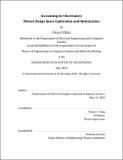| dc.contributor.advisor | Maria C. Yang. | en_US |
| dc.contributor.author | Pillai, Priya P. | en_US |
| dc.contributor.other | Massachusetts Institute of Technology. Department of Electrical Engineering and Computer Science. | en_US |
| dc.date.accessioned | 2020-09-15T21:58:00Z | |
| dc.date.available | 2020-09-15T21:58:00Z | |
| dc.date.copyright | 2020 | en_US |
| dc.date.issued | 2020 | en_US |
| dc.identifier.uri | https://hdl.handle.net/1721.1/127438 | |
| dc.description | Thesis: M. Eng., Massachusetts Institute of Technology, Department of Electrical Engineering and Computer Science, May, 2020 | en_US |
| dc.description | Cataloged from the official PDF of thesis. | en_US |
| dc.description | Includes bibliographical references (pages 51-54). | en_US |
| dc.description.abstract | Engineers design for an inherently uncertain world. In the early stages of design processes, they commonly account for such uncertainty either by manually choosing a specific worst-case and multiplying uncertain parameters with safety factors or by using Monte Carlo simulations to estimate the probabilistic boundaries in which their design is feasible. The safety factors of this first practice are determined by industry and organizational standards, providing a limited account of uncertainty; the second practice is time intensive, requiring the development of separate testing infrastructure. In theory, robust optimization provides an alternative, allowing set based conceptualizations of uncertainty to be represented during model development as optimizable design parameters. The hybrid intelligent design perspective, considering the ways in which humans and computers interact as teams in order to solve engineering design problems, prompts the question of how these theoretical benefits translate to design practice. In this work, we analyzed present use of geometric programs as design models in the aerospace industry to determine the current state-of-the-art, then conducted a human-subjects experiment to investigate how various mathematical representations of uncertainty affect design space exploration. We found that robust optimization led to far more efficient explorations of possible designs with only small differences in an experimental participant's understanding of their model. Specifically, the Pareto frontier of a typical participant using robust optimization left less performance "on the table" across various levels of risk than the very best frontiers of participants using industry-standard practices. This analysis perspective can be applied broadly to provide insight on how design concept generation is affected by the inclusion of computational tools. | en_US |
| dc.description.statementofresponsibility | by Priya P. Pillai. | en_US |
| dc.format.extent | 54 pages | en_US |
| dc.language.iso | eng | en_US |
| dc.publisher | Massachusetts Institute of Technology | en_US |
| dc.rights | MIT theses may be protected by copyright. Please reuse MIT thesis content according to the MIT Libraries Permissions Policy, which is available through the URL provided. | en_US |
| dc.rights.uri | http://dspace.mit.edu/handle/1721.1/7582 | en_US |
| dc.subject | Electrical Engineering and Computer Science. | en_US |
| dc.title | Accounting for uncertainty : robust design space exploration and optimization | en_US |
| dc.type | Thesis | en_US |
| dc.description.degree | M. Eng. | en_US |
| dc.contributor.department | Massachusetts Institute of Technology. Department of Electrical Engineering and Computer Science | en_US |
| dc.identifier.oclc | 1192966252 | en_US |
| dc.description.collection | M.Eng. Massachusetts Institute of Technology, Department of Electrical Engineering and Computer Science | en_US |
| dspace.imported | 2020-09-15T21:57:59Z | en_US |
| mit.thesis.degree | Master | en_US |
| mit.thesis.department | EECS | en_US |
